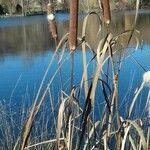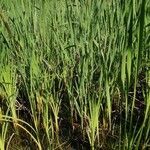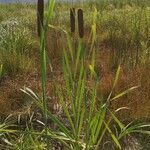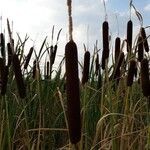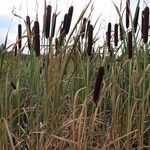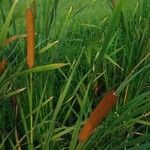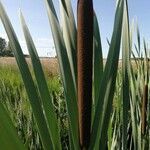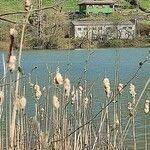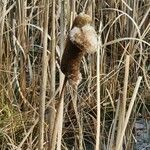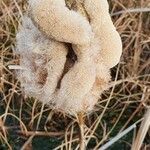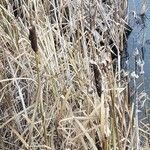Stems erect, stout 1.5–3.5 m. high.. Leaf-sheaths abruptly rounded to auriculate at the junction with the blade and scarious-margined, sometimes purple-spotted within; blade linear, up to 2 m. long, 8–10 mm. wide, with an obtuse tip and narrow base, the base flat above and convex beneath in dried material, glabrous, glaucous.. Inflorescence of contiguous spikes, each subtended by a caducous foliaceous bract, the ♀ spike sometimes constricted or interrupted, each part with a subtending bract and separated by 0–3.5 cm.. Male spike 8–12 cm. long, l.3–l.8(–2.5) cm. wide at maturity; bracteoles linear, beige or pinkish-fawn, ± as long as the stamens; stamens with white filaments stouter than the bracteoles; anthers 3–4 mm. long with the connective produced into an obtuse rounded black tip as broad as the anther, or broader; mature pollen grains adhering in tetrads, pale primrose-yellow.. Female spike 13–16(–25) cm. long, 2.5–3.5(–4) cm. wide, yellow-green at first, becoming dark sepia-brown or almost black at maturity; pedicels numerous, filiform, 20–30 per sq. mm.; bracteoles not present; carpodia pale, speckled with red, ± as long as the perigonous hairs; fertile flowers with a broadly lanceolate stigma much longer than the perigonous hairs.. Fig. 1/9, p. 3.
Stems 1–3 m; lvs flat, (8–)10–23 mm wide; pistillate and staminate portions of the spike contiguous, or rarely separated by as much as 4 mm, the pistillate portion brown, 10–15 cm, 2–3 cm thick at maturity; compound pedicels long and slender; pistillate bracteoles wanting; stigma broad and thick, spatulate; fr 1 cm, with copious white hairs arising near the base (these linear, not expanded upwards), the achene 1 mm long, above the middle of the whole fr; sterile pistillate fls about as long as the fertile and similarly hairy, expanded into a spatulate tip; staminate bracteoles white, capillary; pollen in tetrads; 2n=30. Clean marshes; nearly cosmop., and throughout our range, the common sp. inland. Hybrids with the next 2 spp. have been called T. ×glauca Godr.
Stems 1-2.5 m tall, stout. Leaves 45-95 cm × 5-15 mm, abaxially convex, transverse section semilunate. Male part of spikes 3.5-12 cm, with 1-3 deciduous bracts at base or occasionally in middle portion; female part of spikes not separated from male part, 5-23 cm. Male flowers: stamens usually 2; anthers ca. 3 mm. Female flowers without bracteoles; ovary lanceolate; stalk ca. 4 mm, slender; styles 2.5-3 mm; stigmas lanceolate, 1-1.2 mm; hairs on stalk shorter than style. Fruit lanceolate. Fl. and fr. May-Aug. 2n = 30.
Flowering stems to 2.5 m tall. Leaves greyish green; sheath of upper leaves auriculate; lamina to 1 m long, 1-2 cm wide. Male and female inflorescences contiguous or to 0.5 cm apart. Male inflorescences 6-16 cm long, 1-1.5 cm diam.; pollen shed in tetrads. Female inflorescences 10-20 cm long, 1.7-2.5 cm diam., blackish brown or rarely red-brown; floral bracts absent. Stigma narrowly obovate to obovate, usually flat, somewhat fleshy and black tipped.
A herb. It is a reed which grows in water. They spread by underground rhizomes. The leaves are bluish-green and like straps. They can be 2-2.5 m long and 2.5 cm wide. The flower heads form a compact cylinder. This is 15-23 cm long and 2.5 cm across. The upper part is male and yellow. The lower part is female and stays dark brown. These are not separated. The seeds have hairs attached to them.
Tall aquatic herb up to 9 ft. high
Female inflorescence brown
